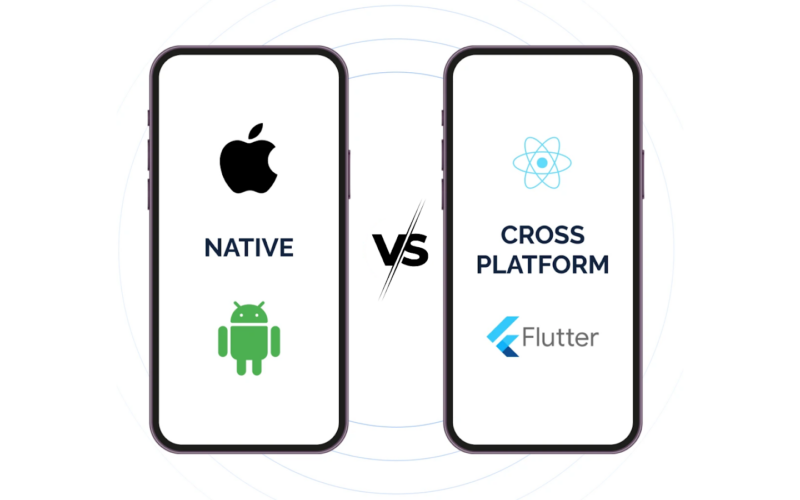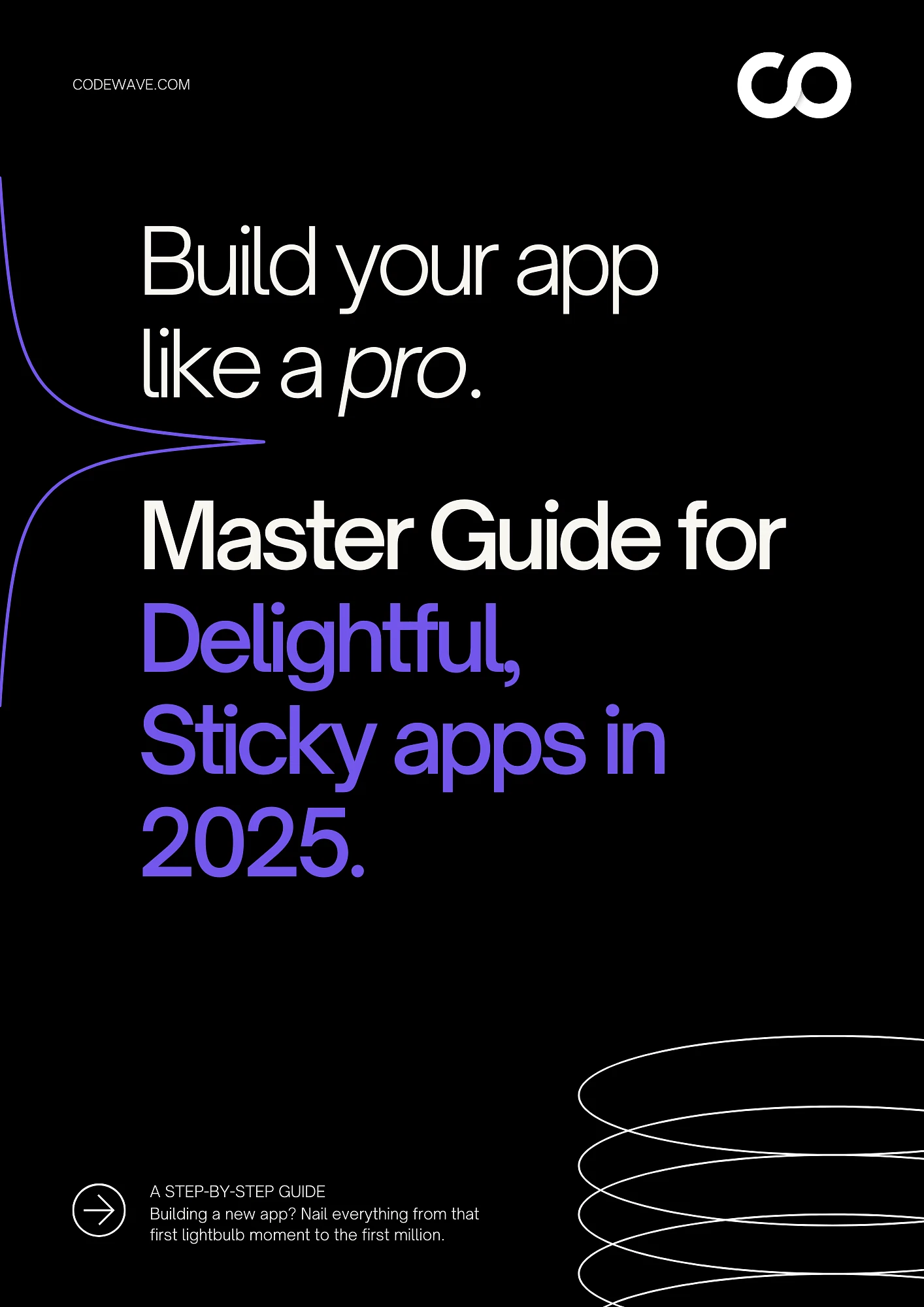Mobile app usage in Australia is booming. According to Red Search, it is estimated that Australia will reach an 86.6% penetration rate in 2024, representing just over 23 million users across the country. With nearly nine in ten Australians using smartphones, businesses can’t afford to ignore a solid mobile presence.
Building an app is now essential, not optional for customer engagement, service delivery, and driving revenue. Yet the pivotal decision remains: native or cross platform development?
Native gives you performance and deep OS integration, ideal for advanced features like AR or biometrics. Cross platform, using frameworks like React Native or Flutter, offers faster development and unified maintenance for both iOS and Android.
If you lead product, tech, or digital experience at an Australian company, this guide will help you decide. We’ll unpack the differences, highlight local market implications, and offer a structured decision path so you deliver value faster and smarter through mobile app development Australia.
Key Takeaways:
- Mobile app usage in Australia exceeds 86% of the population
- Native offers top performance and full hardware access for complex use cases
- Cross-platform speeds up delivery and reduces cost for MVPs and internal tools
- Total cost of ownership matters more than just build cost
- App store success relies on localised listings, timing, and regional rollouts
- Privacy Act compliance and secure data handling are business-critical
- Mistakes like ignoring offline access or skipping local QA hurt app performance
- Use platform choice to match your product goals, budget, and market timeline
What Is Native and Cross-Platform App Development?
Before getting into the tradeoffs, it is important to define what native and cross platform mobile development actually mean in practice.
Native Mobile Apps
Native apps are built specifically for one operating system using the official tools and languages provided by that platform. These apps are installed directly on the device through app stores and have full access to system features.
Common tools and languages for native development:
- iOS: Swift or Objective-C using Xcode
- Android: Kotlin or Java using Android Studio
- Designed and optimized separately for each platform
- Best suited for apps requiring deep OS integration, advanced hardware access, or demanding performance (e.g. gaming, AR, biometrics)
Cross Platform Mobile Apps
Cross platform development lets you write one codebase that runs on both iOS and Android. It uses frameworks that bridge the gap between native capabilities and shared UI logic.
Popular cross platform frameworks:
- React Native by Meta
- Flutter by Google
- Xamarin by Microsoft (less common now)
- Ideal for startups, MVPs, and apps with simple to moderate feature requirements
- Faster to build and easier to maintain across platforms
Some apps are built as hybrid apps using web technologies wrapped in a native shell. These rely on frameworks like Ionic or Cordova but are increasingly being replaced by more performant solutions like Flutter.
Progressive Web Apps (PWAs) offer app-like functionality directly in the browser. They work well for lightweight use cases but have limited access to device features and are not listed in app stores.
Also read: Step by Step Guide to Mobile App Development for Businesses
Native vs Cross-Platform for Australian Businesses
Once you understand what native and cross-platform apps are, the next step is evaluating how they perform in real business scenarios; especially under Australian budget, talent, and market constraints.
| Criteria | Native Development | Cross-Platform Development |
| Performance | High. Optimised for each OS with direct access to hardware | Moderate to High. Good enough for most business apps; may lag under heavy loads |
| User Experience | Seamless. Matches platform-specific design and interaction standards | Consistent across platforms but may lack native feel in some UI/UX details |
| Speed to Market | Slower. Requires separate development for iOS and Android | Faster. Single codebase for both platforms speeds up delivery |
| Maintenance | Higher ongoing effort and cost. Two codebases to update and test | Easier maintenance. One codebase simplifies bug fixes and feature rollouts |
| Device Feature Access | Full access to all native APIs and hardware (camera, GPS, sensors) | Access via plugins or bridges. Can cover most needs but may hit limits |
| Budget Suitability | Better for funded projects, complex apps, or high-scale B2C/B2B use | Ideal for startups, MVPs, internal tools, and time-sensitive rollouts |
| Team Requirements | Requires dedicated iOS and Android developers | Can be built by one full-stack mobile team with Flutter or React Native skills |
| Best Use Cases | High-performance apps, fintech, AR, gaming, rural-first services | MVPs, ecommerce, loyalty apps, government or council tools, education platforms |
Total Cost of Ownership in Australia
When comparing native and cross-platform development, looking only at upfront build cost gives an incomplete picture. Total cost of ownership (TCO) includes all costs incurred over the life of your app; from launch through maintenance, updates, and scaling.
Here’s how the two approaches differ when you assess TCO over time:
| Cost Factor | Native Development | Cross-Platform Development |
| Initial Development | Higher. Separate codebases for iOS and Android increase time and effort | Lower. Single codebase reduces engineering hours and design duplication |
| App Store Compliance & Device Testing | Testing and certification required separately for each OS | One round of testing across platforms (but still must check platform-specific behavior) |
| Ongoing Maintenance | Double the maintenance for updates, bug fixes, and OS changes | Faster updates across both platforms with one codebase |
| Feature Expansion | Requires custom implementation per platform | Can reuse logic but may need native modules for advanced features |
| Developer Resourcing | Requires iOS and Android specialists | Can be managed by a unified team skilled in Flutter or React Native |
| Hidden Costs | Performance optimisation and crash analytics per platform | Plugin limitations or performance tuning on large-scale apps |
What This Means for Australian Businesses:
- Startups and SMBs with limited dev teams or funding cycles benefit from cross-platform in the first 12–24 months
- Enterprises or public sector apps with longer life cycles may find native more cost-efficient beyond 3–5 years, especially if advanced features are required
- Grant-funded or pilot initiatives can reduce TCO further by starting cross-platform and extending features natively later
If budget flexibility is limited, cross-platform allows you to deliver value faster without overcommitting. But if your roadmap includes high-volume usage or complex integrations, factor in the compounding costs of maintaining multiple stacks with native.
Also read: Hybrid vs Native App Development: Which is the Best for Your Business?
App Store Strategy for Australia
Launching a mobile app is not just about getting approval from Apple or Google. It’s about how your app performs on Australian app stores and how quickly it drives business outcomes like installs, conversions, and retention.
Here’s how to optimise your launch strategy specifically for the Australian market:
1. Localise Your App Store Listings for Australian Search Behaviour
- Use keywords Australians search for in your App Store Optimization (ASO) titles and descriptions, like “tradie job tracker” or “Aussie budget planner”
- Reflect local currency, date formats, and measurements in screenshots and descriptions
- Include region-specific value props, such as GST support, NDIS tracking, or local delivery coverage
2. Target Peak Launch Windows That Align with Local Campaigns
- Aim for pre-holiday or financial year periods (May–June, October–December) when app install intent is high
- Coordinate with local marketing spend for tax-time utilities, Black Friday, Boxing Day, or back-to-school seasons
3. Choose the Right App Category for Visibility
- iOS and Google Play categories affect who sees your app
- In Australia, top-performing app categories for business and service growth include:
- Finance and budgeting
- Healthcare and wellness
- Local services and councils
- Education and training
- Shopping and loyalty
4. Soft Launch in a Regional State Before Going National
- Test your app in one state or metro area (e.g. Victoria or WA) to gather install and usage feedback
- Optimise onboarding, crash handling, and UX before scaling nationally
5. Drive Early Reviews and Ratings Through Local Outreach
- Partner with micro-influencers, industry forums, or Reddit AU communities for early exposure
- Incentivise early users to leave ratings via in-app prompts (compliant with store guidelines)
Business Outcomes for Australia-Based Launches:
- Faster App Store ranking by aligning with local relevance and search behavior
- Higher install-to-retention ratio by fine-tuning UX for Australian expectations
- Stronger ROI on paid campaigns by syncing launch with national calendar cycles
- Lower support overhead with fewer post-launch fixes thanks to regional soft rollouts
Privacy and Compliance in Australia
For Australian businesses, mobile apps are more than just user-facing tools; they’re a gateway to sensitive customer data, regulated transactions, and brand trust. Choosing the wrong development approach or skipping local compliance considerations can expose your company to legal risk, lost revenue, and reputational damage.
Key Security & Compliance Considerations for Mobile Apps in Australia
Australian businesses must address these areas during mobile app development; regardless of whether the app is native or cross-platform:
- Privacy Act 1988 and Australian Privacy Principles (APPs): Mobile apps must clearly state how user data is collected, used, and stored, with opt-in consent for tracking, location, and third-party sharing.
- Data residency and hosting: Storing customer data in Australia (or approved jurisdictions) is critical for industries like health, finance, education, and government. Choose cloud providers with Australian data centres (AWS Sydney, Azure Australia East, GCP Melbourne).
- End-to-end encryption and secure APIs: Data in transit and at rest must be encrypted. All mobile app endpoints should be secured using OAuth 2.0 or JWT and undergo regular penetration testing.
- In-app permissions and OS-level controls: Apps must request permissions (e.g., camera, contacts, location) with just-in-time context and minimise what’s collected.
- Regulatory overlays in sectors like:
- Healthcare: Must comply with My Health Record standards and Australian Digital Health Agency (ADHA) guidelines.
- Finance: Apps handling transactions must meet APRA CPS 234 and ASIC security standards.
- Education: Apps in schools or universities must comply with FER standards for youth data handling.
Business Impact: Why Compliance Drives Competitive Advantage
Failing to meet Australian privacy or security standards is more than a legal issue; it’s a barrier to growth.
What businesses gain from secure mobile builds:
- Shorter sales cycles, especially in B2B and public sector procurement
- Greater user trust and higher app retention
- Easier expansion into regulated markets (healthtech, edtech, fintech)
- Stronger eligibility for grants, certifications, or enterprise partnerships
Choosing the Right Path for Your App
There’s no universal answer to native vs cross-platform. The right approach depends on your app’s purpose, audience, budget, and long-term goals. Here’s a decision framework to help you evaluate your best path forward. Key Factors to Consider:
1. Time to Market
- Need to launch quickly for seasonal demand or a pilot program?
Go cross-platform - Have time for phased rollout with full optimisation?
Consider native
2. Performance Requirements
- Does your app rely on real-time processing, high FPS, or advanced graphics?
Native is better - Is performance important but not critical?
Cross-platform can suffice with frameworks like Flutter
3. Target User Expectations
- Are your users likely to expect a premium or OS-specific experience? (e.g., fintech, health, gaming)
Native recommended - Will your app serve general utility across platforms (e.g., bookings, internal tools)?
Cross-platform will meet needs
4. Budget and Resources
- Limited development budget or single dev team?
Cross-platform maximises ROI - Larger team with platform expertise and scale-up plans?
Native gives more long-term flexibility
5. Regulatory or Security Demands
- Do you operate in sectors like finance, healthcare, or government?
Native allows more control over data handling - Are data privacy and local compliance still a priority but not highly complex?
Cross-platform frameworks with proper APIs and encryption still meet Australian standards
Common Mistakes by Australian Companies
Even with clear requirements, businesses often fall into predictable traps during mobile development planning. These mistakes can delay launches, inflate budgets, or result in poor user experience.
1. Choosing Based on Developer Preference, Not Business Needs
It’s easy to let internal teams lead with what they know best; like going native because your devs are fluent in Swift or Kotlin. But this can misalign with business goals.
Instead: Evaluate tech based on your market, timeline, and app goals; not team familiarity alone.
2. Underestimating Maintenance Complexity
Cross-platform seems simpler upfront, but poorly managed codebases can get bloated over time, especially if OS-specific features are bolted on later.
Instead: Plan for long-term maintainability from day one, with proper abstraction for platform-specific elements.
3. Ignoring Offline or Low-Bandwidth Scenarios
This matters particularly in regional or remote parts of Australia where 5G or even 4G isn’t consistent.
Instead: Prioritise offline readiness and optimise data sync regardless of development path.
4. Not Testing on Local Devices or Networks
Australian carriers, devices, and mobile behaviours vary. Apps that work fine overseas might have glitches here.
Instead: Include real-world testing on Australian networks and devices early in your QA pipeline.
5. Over-automating UX Decisions
Some businesses overuse shared UI components from cross-platform libraries without localising the experience. This can result in apps that feel “off” to Aussie users.
Instead: Even in cross-platform builds, customise UI to meet native expectations on iOS and Android where needed.
6. Missing Out on Government Grants or Digital Uplift Programs
Australia offers local support for tech innovation and digital transformation, but many businesses don’t factor this into budgeting.
Instead: Check eligibility for local grants like the Business Research and Innovation Initiative (BRII) to support native or cross-platform app funding.
How Codewave Supports Mobile App Development
Choosing between native and cross-platform is not just a technical decision. It impacts your product velocity, budget cycles, user satisfaction, and compliance with local standards. At Codewave, we focus on aligning technology with business impact from the start.
Co-Designing with Business Stakeholders
We begin by mapping out:
- Your product vision and roadmap
- Revenue and retention goals tied to the app
- Market launch plans including seasonality or campaign windows
This helps determine whether rapid delivery with cross-platform or deep device integration via native will best support your strategy.
Have a brilliant product idea, but not sure if it’ll work?
Technical Feasibility Assessment Before You Build
Codewave performs early-stage analysis to validate:
- Performance needs across devices common in Australia
- Required access to native APIs like camera, Bluetooth, biometric security
- Dependencies on platform-specific SDKs or third-party tools
This prevents surprises mid-build and ensures that platform choice matches app complexity.
Lean MVP First, Full Native or Hybrid Later
For many clients, we launch with a cross-platform MVP using Flutter or React Native. This allows:
- Rapid testing of market response
- Lower initial investment
- Faster release to both app stores
Then we scale select features into native modules where needed; for example, adding high-speed AR or background geolocation as native components.
Embedded UX and Accessibility Review
Apps built for Australia must support local user expectations, accessibility norms, and culturally relevant design. Codewave integrates:
- Accessibility testing aligned with WCAG AA standards
- Local UX research to shape interaction flows
- Consistency with platform-specific design patterns like Material and Human Interface Guidelines
This ensures your app feels native regardless of how it’s built.
Post-Launch Maintenance Plans with Australian Context
Codewave doesn’t stop at go-live. We help plan:
- Release cycles based on iOS and Android update calendars
- Testing matrices for devices common in Australian retail and enterprise use
- In-app analytics tied to business KPIs like conversion, usage, and churn
That means your mobile app evolves in sync with both technology shifts and customer expectations.
Build Apps that engage, delight people and grow your business!
Start Your Mobile App Journey with Confidence
Whether you are building a mobile-first business or extending an existing service, the choice between native and cross-platform will shape your app’s future. Codewave helps you make that choice with clarity, backed by deep technical insights and real-world market understanding.
We work closely with Australian businesses to:
- Validate platform tradeoffs based on actual usage needs
- Prototype quickly without locking into premature tech choices
- Align design, performance, and budget goals with the right stack
Ready to build an app that delivers long-term value? Book a mobile app strategy session.
Let’s build something that works today and scales tomorrow.
Frequently Asked Questions
Q: How much does it cost to develop a mobile app in Australia?
Ans: The cost of mobile app development in Australia ranges from AUD 30,000 to over AUD 250,000 depending on the complexity, platform (native vs cross-platform), and integrations involved. A basic MVP might cost under AUD 50,000 while high-scale enterprise apps can exceed AUD 300,000 when including design, testing, and post-launch support.
Q: How much does it cost to pay someone to build a mobile app?
Ans: Freelancers and offshore developers might charge lower rates, but Australian agencies typically quote between AUD 120–200 per hour. A full-cycle development engagement with a local agency; including strategy, UX, dev, and QA may start around AUD 60,000 for cross-platform apps and go higher for native apps with complex backend systems.
Q: How to launch an app in Australia?
Ans: Launching an app in Australia involves:
- Registering an Apple Developer and Google Play account
- Localising app store listings for Australian users
- Complying with data and accessibility regulations
- Testing on local devices and networks
- Timing the launch with seasonal campaigns or government calendars
A regional soft launch (e.g. in Victoria) can help gather feedback before national rollout.
Q: Are mobile app developers still in demand?
Ans: Yes. Demand for mobile app developers remains strong in Australia, especially for developers skilled in Flutter, React Native, Swift, and Kotlin. Sectors like healthtech, fintech, logistics, and e-commerce continue to invest heavily in mobile-first solutions, keeping developer roles in high demand across both startups and enterprises.
Q: Will AI replace mobile developers?
Ans: AI can automate parts of mobile development like UI generation, code scaffolding, or QA testing. However, human developers are still critical for architecture decisions, user experience design, and secure integrations. AI enhances developer productivity but is unlikely to fully replace mobile roles in the near future.
Codewave is a UX first design thinking & digital transformation services company, designing & engineering innovative mobile apps, cloud, & edge solutions.







